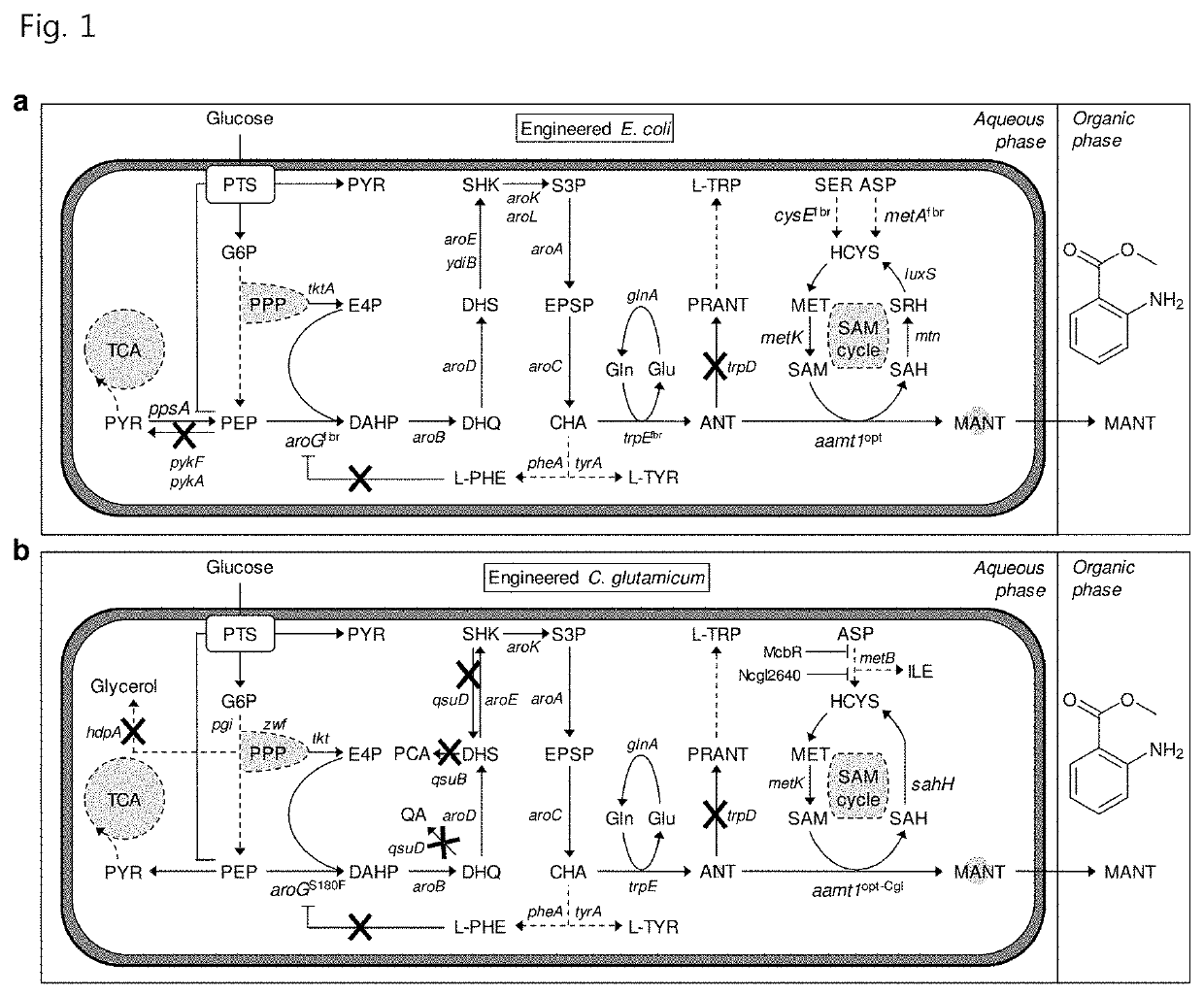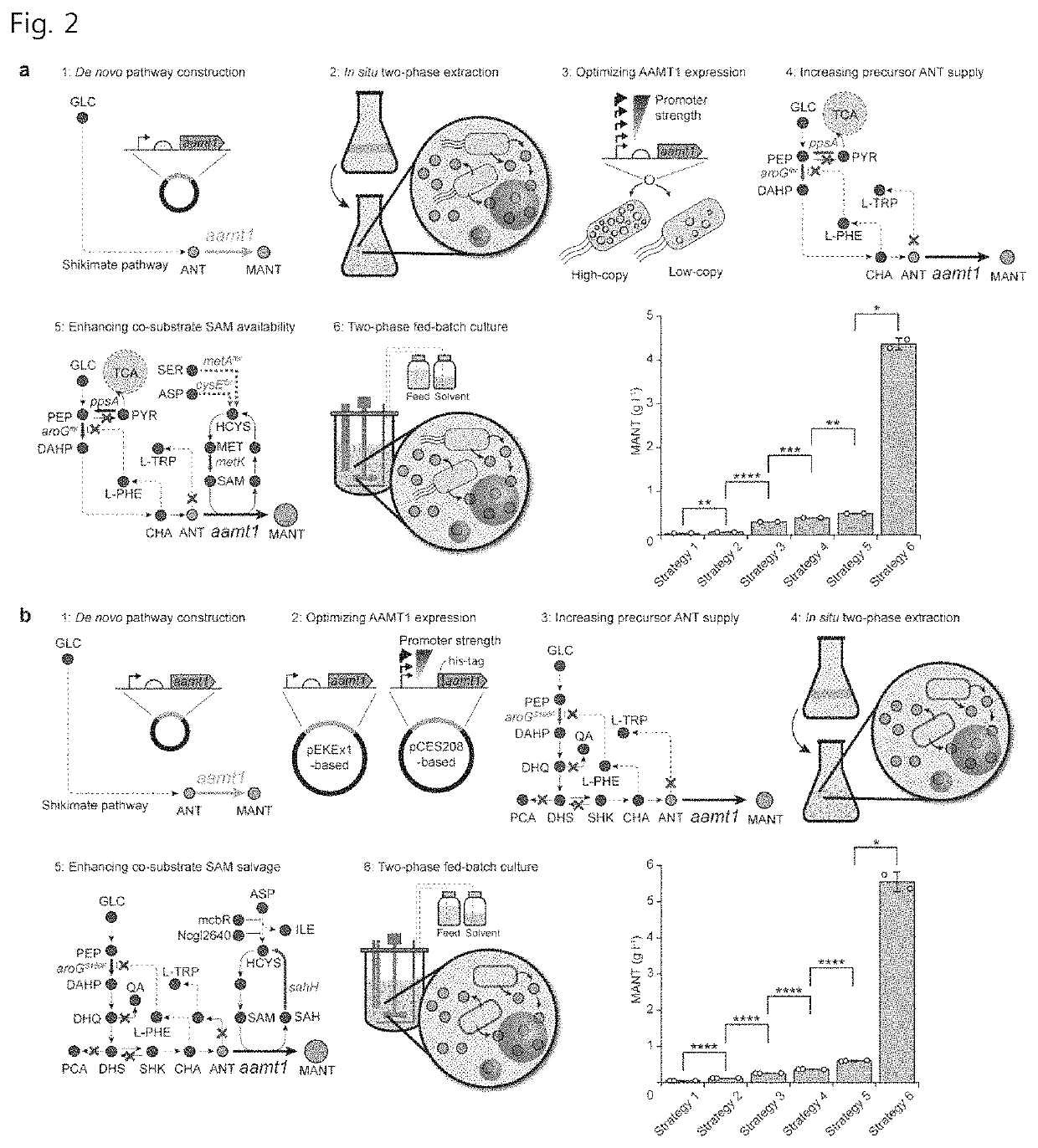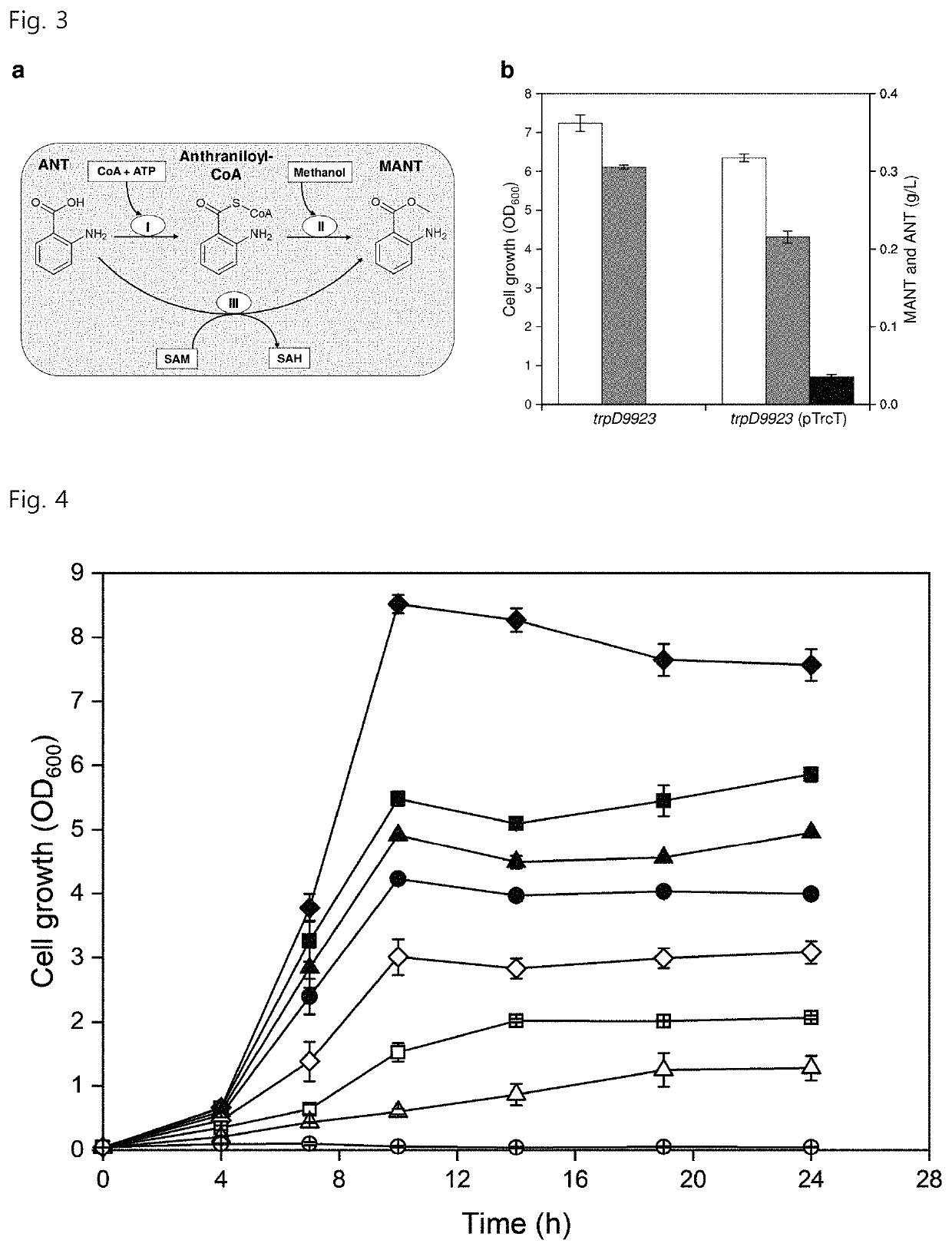Recombinant microorganism capable of producing methyl anthranilate and method of producing methyl anthranilate using the same
a technology of methyl anthranilate and recombinant microorganisms, which is applied in the direction of enzymology, viruses/bacteriophages, transferases, etc., can solve the problems of large quantity of acid catalysts, inability to directly extract mant from plants, and difficulty in achieving high value-added methyl
- Summary
- Abstract
- Description
- Claims
- Application Information
AI Technical Summary
Benefits of technology
Problems solved by technology
Method used
Image
Examples
example 1
Construction of MANT Biosynthesis Pathway
[0084]1-1. Selection of Metabolic Circuit from ANT to MANT
[0085]Research commenced based on mechanisms of MANT biosynthesis in plants due to the lack of sufficient research on MANT metabolism in E. coli and C. glutamicum strains used in the present invention. Two different enzymes, anthraniloyl-CoA:methanol acyltransferase and SAM-dependent methyltransferase, are reported to mediate biosynthesis of MANT from anthranilate in plants (FIG. 3 in part a). Both routes share the same precursor metabolite ANT, which is derived from the L-tryptophan (L-TRP) biosynthesis pathway in plants. The present invention focuses on selection of SAM-dependent methyltransferase encoded by aamt1 rather than anthraniloyl-CoA:methanol acyltransferase in designing metabolic pathways for MANT biosynthesis for the following reasons. First, anthraniloyl-CoA:methanol acyltransferase requires two steps (CoA activation and acyl transfer) for production of MANT from anthrani...
example 5 manipulation
of Availability of Co-Substrate SAM to Improve MANT Production
[0123]5-1. Manipulation of Availability of Co-Substrate SAM
[0124]In order to increase the production of MANT from the produced ANT, an attempt was made to improve the availability of SAM as a co-substrate. First, in order to increase the availability of SAM, the mutants of homoserine O-succinyltransferase expressed by the metAfbr gene and the L-serine O-acetyltransferase expressed by the cysEfbr gene, which are feedback-resistant were overexpressed, and the result was observed.
[0125]For this purpose, a pBBR1GfbrAfbrEfbr vector was constructed. First, RBS-metAfbr (encoding MetAR27C, I296S, P298L) was amplified with SEQ ID NO: 38 and SEQ ID NO: 39 and then inserted into vector pBBR1Gfbr cleaved with HindIII and PstI to produce a vector pBBR1GfbrAfbr. Next, RBS-cysEfbr (encoding CysEV95R,D96P) was amplified with SEQ ID NO: 40 and SEQ ID NO: 41 and inserted into the vector pBBR1GfbrAfbr cleaved with BamHI to produce a vector ...
example 13
Additional Sequence Information
[0210]13-1. ammt1
[0211]
Zea mays ammt1 original gene sequenceatgccgatgagaatcgagcgtgatctccacatggccatagggaacggagaaactagctacacaaaaaattctaggattcaagagaaagctatgtttcagatgaagtcggtccttgaggaggccactagagcagtatgcacaactctcctcccacaaaccatggttgtggccgacttaggctgctcatcagggcctaacacactgcgcttcgtcactgaggtgactagaatcatagctcaccattgcaagctggagcacaaccgacgacatgaccacctgccgcagcttcagttctttctgaatgacctgcctggtaacgacttcaacaatctcttccagctcatcgagcagttcaataagtcatcgacgacacacaagggagatgcagcaactgaggcactacagcctccttgctatatctccggattgccgggctcctactacactaggatcttccctagcgaaagcgttcatcttttccactctctgttctgccttcagtggcgctctcaggcaccagagcaactgaagggcacccaaaaatcatgcctagatatctacatcacaaagactatgtcaccatcgatggtgaagttgtttcaacagcagtttcagaaggacttctccctcttcctcaggctacgctatgaggaactcgtgtctggtggccaaatggttctaacatttattggaaggaagcatgaggatgtgttcactggagagtccaaccatctttacggattgcttgcgcagtcactgaaatccctagttgatgagggtcttgtggagaaagaaaaacttgagtcattctatcttccgatctactcaccgtcggttggtgaagtggaggcgatagtgaagcaacttgggttgttcaacatgaatcatgttaaagtatttgagata...
PUM
 Login to View More
Login to View More Abstract
Description
Claims
Application Information
 Login to View More
Login to View More - R&D
- Intellectual Property
- Life Sciences
- Materials
- Tech Scout
- Unparalleled Data Quality
- Higher Quality Content
- 60% Fewer Hallucinations
Browse by: Latest US Patents, China's latest patents, Technical Efficacy Thesaurus, Application Domain, Technology Topic, Popular Technical Reports.
© 2025 PatSnap. All rights reserved.Legal|Privacy policy|Modern Slavery Act Transparency Statement|Sitemap|About US| Contact US: help@patsnap.com



